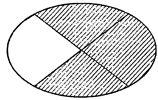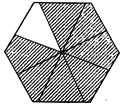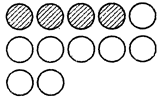-
question_answer1)
An apple is cut into 4 equal parts. Each equal parts of the apple is __________
A)
One-fourth done
clear
B)
One-third done
clear
C)
One-fifth done
clear
D)
Half done
clear
E)
None of these done
clear
View Solution play_arrow
-
question_answer2)
Which among the following statements is true?
A)
For a whole unit, one out of 4 equal parts of the whole is represented as \[\frac{1}{2}\] done
clear
B)
For a whole unit, three out of 8 equal parts is represented as\[\frac{1}{8}\]. done
clear
C)
In a fraction, denominator is the number of parts, the whole is divided into. done
clear
D)
All the above done
clear
E)
None of these done
clear
View Solution play_arrow
-
question_answer3)
Which one among the following is correct representation of shaded part to whole?
A)
B)
C)
D)
All the above done
clear
E)
None of these done
clear
View Solution play_arrow
-
question_answer4)
Directions: In each of the following figures, find the fraction of the shaded part.

A)
\[\frac{2}{8}\] done
clear
B)
\[\frac{6}{8}\] done
clear
C)
\[\frac{5}{8}\] done
clear
D)
\[\frac{1}{4}\] done
clear
E)
None of these done
clear
View Solution play_arrow
-
question_answer5)
Directions: In each of the following figures, find the fraction of the shaded part.

A)
\[\frac{16}{32}\] done
clear
B)
\[\frac{1}{2}\] done
clear
C)
\[\frac{8}{16}\] done
clear
D)
All of the above done
clear
E)
None of these done
clear
View Solution play_arrow
-
question_answer6)
Directions: In each of the following figures, find the fraction of the shaded part.

A)
\[\frac{4}{9}\] done
clear
B)
\[\frac{3}{10}\] done
clear
C)
\[\frac{4}{10}\] done
clear
D)
\[\frac{10}{4}\] done
clear
E)
None of these done
clear
View Solution play_arrow
-
question_answer7)
Which one among the following is not an equivalent fraction of\[\frac{\mathbf{3}}{\mathbf{12}}\]?
A)
\[\frac{6}{24}\] done
clear
B)
\[\frac{7}{16}\] done
clear
C)
\[\frac{9}{36}\] done
clear
D)
\[\frac{12}{48}\] done
clear
E)
None of these done
clear
View Solution play_arrow
-
question_answer8)
Directions: In each of the following questions a fraction showing shaded part of whole figure is given. Identify the fraction with correct figure: \[\frac{\mathbf{3}}{\mathbf{4}}\]
A)
B)
C)
D)
All the above done
clear
E)
None of these done
clear
View Solution play_arrow
-
question_answer9)
Directions: In each of the following questions a fraction showing shaded part of whole figure is given. Identify the fraction with correct figure: \[\frac{\mathbf{5}}{\mathbf{8}}\]
A)
B)
C)
D)
E)
None of these done
clear
View Solution play_arrow
-
question_answer10)
Directions: In each of the following questions a fraction showing shaded part of whole figure is given. Identify the fraction with correct figure: \[\frac{\mathbf{2}}{\mathbf{3}}\]
A)
B)
C)
D)
All the above done
clear
E)
None of these done
clear
View Solution play_arrow
-
question_answer11)
In \[\frac{\mathbf{1}}{\mathbf{5}}\], whole is divided into
A)
5 equal parts. done
clear
B)
3 equal parts. done
clear
C)
8 equal parts. done
clear
D)
2 equal parts. done
clear
E)
None of these done
clear
View Solution play_arrow
-
question_answer12)
In \[\frac{\mathbf{3}}{\mathbf{8}}\]; whole is divided into ___________
A)
3 equal parts done
clear
B)
8 equal parts done
clear
C)
5 equal parts done
clear
D)
11 equal parts done
clear
E)
None of these done
clear
View Solution play_arrow
-
question_answer13)
A fraction \[\frac{\mathbf{3}}{\mathbf{8}}\] describes that
A)
Out of the three equal part of a whole, 1 part is\[\frac{2}{3}\]. done
clear
B)
Out of the 5 equal parts of a whole, 3 parts is\[\frac{2}{3}\]. done
clear
C)
Out of the 5 equal parts of a whole, 2 parts is\[\frac{2}{3}\] . done
clear
D)
Out of the 3 equal parts of a whole, 2 parts is\[\frac{2}{3}\] . done
clear
E)
None of these done
clear
View Solution play_arrow
-
question_answer14)
Identify the unlike fractions from the following:
A)
\[\frac{6}{8}\,\,and\,\frac{5}{8}\] done
clear
B)
\[\frac{5}{9}\,\,and\,\frac{4}{9}\] done
clear
C)
\[\frac{3}{6}\,\,and\,\frac{4}{6}\] done
clear
D)
\[\frac{3}{5}\,\,and\,\frac{9}{10}\] done
clear
E)
None of these done
clear
View Solution play_arrow
-
question_answer15)
Arrange the following fractions in ascending order: \[\frac{\mathbf{3}}{\mathbf{7}}\mathbf{,}\,\,\frac{\mathbf{4}}{\mathbf{7}}\mathbf{,}\,\,\frac{\mathbf{1}}{\mathbf{7}}\mathbf{,}\,\,\frac{\mathbf{2}}{\mathbf{7}}\mathbf{,}\,\,\frac{\mathbf{5}}{\mathbf{7}}\]
A)
\[\frac{1}{7}>\,\,\frac{5}{7}>\,\,\frac{4}{7}>\,\,\frac{3}{7}>\,\,\frac{2}{7}\] done
clear
B)
\[\frac{5}{7}<\,\,\frac{4}{7}<\,\,\frac{3}{7}<\,\,\frac{2}{7}<\,\,\frac{1}{7}\] done
clear
C)
\[\frac{1}{7}<\,\,\frac{2}{7}<\,\,\frac{3}{7}<\,\,\frac{4}{7}<\,\,\frac{5}{7}\] done
clear
D)
\[\frac{5}{7}>\,\,\frac{4}{7}>\,\,\frac{3}{7}>\,\,\frac{2}{7}>\,\,\frac{1}{7}\] done
clear
E)
None of these done
clear
View Solution play_arrow
-
question_answer16)
Which one among the following is incorrect?
A)
\[\frac{1}{2}+\frac{1}{2}=1\] done
clear
B)
\[\frac{1}{4}+\frac{1}{4}=\frac{1}{2}\] done
clear
C)
\[\frac{1}{8}+\frac{1}{8}=\frac{1}{4}\] done
clear
D)
\[\frac{1}{6}+\frac{1}{6}=\frac{1}{3}\] done
clear
E)
None of these done
clear
View Solution play_arrow
-
question_answer17)
\[\frac{\mathbf{6}}{\mathbf{15}}\mathbf{-}\frac{\mathbf{2}}{\mathbf{10}}\mathbf{=\_\_\_\_\_}\]
A)
\[\frac{12}{30}-\frac{6}{30}=\frac{6}{30}=\frac{1}{5}\] done
clear
B)
\[\frac{12}{30}-\frac{8}{30}=\frac{4}{30}=\frac{2}{15}\] done
clear
C)
\[\frac{12}{30}-\frac{4}{30}=\frac{8}{30}=\frac{4}{15}\] done
clear
D)
\[\frac{3}{5}-\frac{2}{10}=\frac{1}{10}\] done
clear
E)
None of these done
clear
View Solution play_arrow
-
question_answer18)
Directions: Find the missing numerator or denominator in each of the following questions. \[\frac{\mathbf{3}}{\mathbf{5}}=\frac{\square }{\mathbf{25}},\] Here

is _______.
A)
12 done
clear
B)
9 done
clear
C)
15 done
clear
D)
18 done
clear
E)
None of these done
clear
View Solution play_arrow
-
question_answer19)
Directions: Find the missing numerator or denominator in each of the following questions. \[\frac{\square }{\mathbf{14}}=\frac{\mathbf{22}}{\mathbf{28}},\] here

is _______.
A)
11 done
clear
B)
13 done
clear
C)
9 done
clear
D)
8 done
clear
E)
None of these done
clear
View Solution play_arrow
-
question_answer20)
Directions: Find the missing numerator or denominator in each of the following questions. \[\frac{\mathbf{2}}{\mathbf{9}}=\frac{\mathbf{14}}{\square },\] Here

is _______.
A)
45 done
clear
B)
54 done
clear
C)
63 done
clear
D)
36 done
clear
E)
None of these done
clear
View Solution play_arrow
-
question_answer21)
Directions: Express the shaded parts in each of the following figures:

A)
\[\frac{1}{2}\] done
clear
B)
\[\frac{2}{3}\] done
clear
C)
\[\frac{1}{3}\] done
clear
D)
2 done
clear
E)
None of these done
clear
View Solution play_arrow
-
question_answer22)
Directions: Express the shaded parts in each of the following figures:

A)
\[\frac{2}{4}\] done
clear
B)
\[\frac{3}{5}\] done
clear
C)
\[\frac{4}{9}\] done
clear
D)
\[\frac{4}{10}\] done
clear
E)
None of these done
clear
View Solution play_arrow
-
question_answer23)
Directions: Express the shaded parts in each of the following figures:

A)
\[\frac{1}{6}\] done
clear
B)
\[\frac{3}{6}\] done
clear
C)
\[\frac{2}{6}\] done
clear
D)
\[\frac{1}{4}\] done
clear
E)
None of these done
clear
View Solution play_arrow
-
question_answer24)
Directions: Choose the correct shaded parts of the figure which represents the result on adding two given fractions. \[\frac{\mathbf{1}}{\mathbf{8}}\mathbf{+}\frac{\mathbf{2}}{\mathbf{8}}\mathbf{=\_\_\_\_\_\_}\]
A)
B)
C)
D)
E)
None of these done
clear
View Solution play_arrow
-
question_answer25)
Directions: Choose the correct shaded parts of the figure which represents the result on adding two given fractions. \[\frac{\mathbf{3}}{\mathbf{5}}\,\,\mathbf{+}\,\,\frac{\mathbf{2}}{\mathbf{5}}\,\,\mathbf{=}\,\mathbf{\_\_\_\_\_\_}\]
A)
B)
C)
D)
E)
None of these done
clear
View Solution play_arrow
-
question_answer26)
Directions: Choose the correct shaded parts of the figure which represents the result on adding two given fractions. \[\frac{\mathbf{3}}{\mathbf{14}}\,\,\mathbf{+}\,\,\frac{\mathbf{4}}{\mathbf{14}}\,\,\mathbf{=}\,\mathbf{\_\_\_\_\_\_}\]
A)
B)
C)
D)
E)
None of these done
clear
View Solution play_arrow
-
question_answer27)
Directions: In of the following questions choose the incorrect shaded part for each of the given fraction: \[\frac{\mathbf{3}}{\mathbf{12}}\,\]
A)
B)
C)
D)
E)
None of these done
clear
View Solution play_arrow
-
question_answer28)
Directions: In of the following questions choose the incorrect shaded part for each of the given fraction: \[\frac{\mathbf{1}}{\mathbf{4}}\]
A)
B)
C)
D)
E)
None of these done
clear
View Solution play_arrow
-
question_answer29)
Arrange the following fractions in descending order: \[\frac{\mathbf{1}}{\mathbf{9}}\mathbf{,}\,\,\frac{\mathbf{3}}{\mathbf{9}}\mathbf{,}\,\,\frac{\mathbf{6}}{\mathbf{9}}\mathbf{,}\,\,\frac{\mathbf{2}}{\mathbf{9}}\mathbf{,}\,\,\frac{\mathbf{4}}{\mathbf{9}}\]
A)
\[\frac{6}{9}>\,\,\frac{3}{9}>\,\,\frac{4}{9}>\,\,\frac{2}{9}>\,\,\frac{1}{9}\] done
clear
B)
\[\frac{1}{9}<\,\,\frac{2}{9}<\,\,\frac{3}{9}<\,\,\frac{4}{9}<\,\,\frac{6}{9}\] done
clear
C)
\[\frac{6}{9}>\,\,\frac{4}{9}>\,\,\frac{3}{9}>\,\,\frac{2}{9}>\,\,\frac{1}{9}\] done
clear
D)
\[\frac{6}{9}<\,\,\frac{4}{9}<\,\,\frac{3}{9}<\,\,\frac{2}{9}<\,\,\frac{1}{9}\] done
clear
E)
None of these done
clear
View Solution play_arrow
-
question_answer30)
In the shown figures, the shaded part is showing the fraction. Choose the figure whose fraction is more than \[\frac{\mathbf{2}}{\mathbf{8}}\]and less than\[\frac{\mathbf{4}}{\mathbf{8}}\].
A)
B)
C)
D)
E)
None of these done
clear
View Solution play_arrow
-
question_answer31)
Which one of the following represents a part of whole division of the given line segment.

A)
\[\frac{1}{4}\] done
clear
B)
\[\frac{3}{7}\] done
clear
C)
\[\frac{7}{9}\] done
clear
D)
\[\frac{4}{5}\] done
clear
E)
None of these done
clear
View Solution play_arrow
-
question_answer32)
The common name of both the fractions \[\frac{\mathbf{56}}{\mathbf{121}}\mathbf{,}\,\,\frac{\mathbf{34}}{\mathbf{121}}\] is:
A)
Unlike and improper fractions done
clear
B)
Like and proper fractions done
clear
C)
Improper fractions done
clear
D)
All the above done
clear
E)
None of these done
clear
View Solution play_arrow
-
question_answer33)
Unshaded part of the given picture is:

A)
\[\frac{5}{4}\] done
clear
B)
\[\frac{3}{4}\] done
clear
C)
\[\frac{1}{4}\] done
clear
D)
All the above done
clear
E)
None of these done
clear
View Solution play_arrow
-
question_answer34)
Choose the like fraction of \[\frac{\mathbf{2}}{\mathbf{5}}\]from the following fractions\[\frac{\mathbf{1}}{\mathbf{2}}\mathbf{,}\,\,\frac{\mathbf{3}}{\mathbf{5}}\mathbf{,}\,\,\frac{\mathbf{12}}{\mathbf{5}}\mathbf{,}\,\frac{\mathbf{11}}{\mathbf{3}}\mathbf{:}\]
A)
\[\,\,\frac{3}{5}\mathbf{,}\,\frac{12}{5}\] done
clear
B)
\[\,\,\frac{1}{2}\mathbf{,}\,\frac{3}{5}\] done
clear
C)
\[\,\frac{12}{5}\mathbf{,}\,\frac{11}{3}\] done
clear
D)
All the above done
clear
E)
None of these done
clear
View Solution play_arrow
-
question_answer35)
Add the following fractions:\[\frac{\mathbf{3}}{\mathbf{7}}\mathbf{+}\frac{\mathbf{5}}{\mathbf{7}}\mathbf{+}\frac{\mathbf{8}}{\mathbf{7}}\]
A)
\[\,\frac{7}{11}\] done
clear
B)
\[\,\frac{16}{7}\] done
clear
C)
\[\,\frac{1}{3}\] done
clear
D)
All the above done
clear
E)
None of these done
clear
View Solution play_arrow
-
question_answer36)
Subtract the following fractions: \[\,\frac{\mathbf{8}}{\mathbf{9}}\mathbf{-}\frac{\mathbf{5}}{\mathbf{9}}\].
A)
\[\frac{2}{7}\] done
clear
B)
\[\frac{7}{13}\] done
clear
C)
\[\frac{1}{3}\] done
clear
D)
All the above done
clear
E)
None of these done
clear
View Solution play_arrow
-
question_answer37)
Consider the following statements: Statement 1: Multiplication of two fractions is product of their numerators and denominators. Statement 2: Product of two fractions is always a whole number. Which one of the following is correct about the above statements?
A)
Statement 1 is true and 2 is false done
clear
B)
Statement 1 and 2 both are false done
clear
C)
Statement 2 is true and 1 is false done
clear
D)
All the above done
clear
E)
None of these done
clear
View Solution play_arrow
-
question_answer38)
Unshaded parts of the following picture is a/an:

A)
Improper fraction done
clear
B)
Proper fraction done
clear
C)
Mixed fraction done
clear
D)
All the above done
clear
E)
None of these done
clear
View Solution play_arrow
-
question_answer39)
Simplify: \[\left( \frac{\mathbf{1}}{\mathbf{2}}\mathbf{+}\frac{\mathbf{3}}{\mathbf{2}} \right)\,\,\mathbf{\times }\,\mathbf{4}\]
A)
7 done
clear
B)
2 done
clear
C)
8 done
clear
D)
1 done
clear
E)
None of these done
clear
View Solution play_arrow
-
question_answer40)
Identify the improper fraction from the options given below:
A)
\[\frac{11}{4}\] done
clear
B)
\[\frac{3}{4}\] done
clear
C)
\[\frac{1}{4}\] done
clear
D)
\[\frac{2}{3}\] done
clear
E)
None of these done
clear
View Solution play_arrow
 = \[\frac{1}{4}\] done
clear
= \[\frac{1}{4}\] done
clear
 = \[\frac{3}{8}\] done
clear
= \[\frac{3}{8}\] done
clear
 \[=\frac{2}{4}=\frac{1}{2}\] done
clear
\[=\frac{2}{4}=\frac{1}{2}\] done
clear
 done
clear
done
clear
 done
clear
done
clear
 done
clear
done
clear
 done
clear
done
clear
 done
clear
done
clear
 done
clear
done
clear
 done
clear
done
clear
 done
clear
done
clear
 done
clear
done
clear
 done
clear
done
clear



 done
clear
done
clear
 done
clear
done
clear
 done
clear
done
clear
 done
clear
done
clear
 done
clear
done
clear
 done
clear
done
clear
 done
clear
done
clear
 done
clear
done
clear
 done
clear
done
clear
 done
clear
done
clear
 done
clear
done
clear
 done
clear
done
clear
 done
clear
done
clear
 done
clear
done
clear
 done
clear
done
clear
 done
clear
done
clear
 done
clear
done
clear
 done
clear
done
clear
 done
clear
done
clear
 done
clear
done
clear
 done
clear
done
clear
 done
clear
done
clear
 done
clear
done
clear


